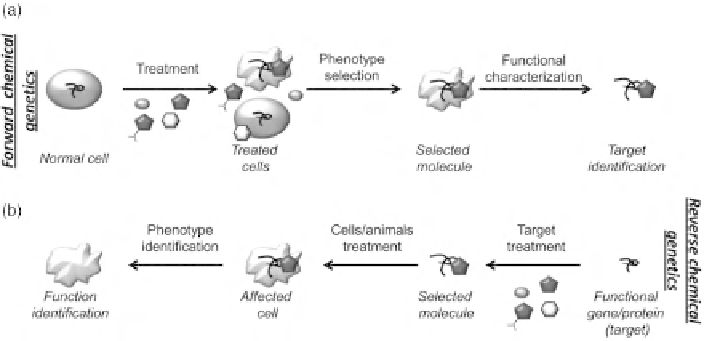Biomedical Engineering Reference
In-Depth Information
Thanks to the synthesis of large chemical libraries, the ideation of a new approach
(chemical genetics) free of the limitations associated with classical genetics became
possible. Chemical genetics was first proposed by S.L. Schreiber in 1998 as “the
study of genes by modulation of protein function with small molecules” [37]. Small
molecules, easily able to permeate cell membranes, can perturb cellular targets rapidly
and often reversibly. Moreover, the perturbation can affect several different features of
the target. Indeed, a small molecule can perturb a selected protein, or one function of
a multifunctional protein, or even disrupt protein-protein interactions. Nevertheless,
chemical genetics also has disadvantages: (1) it is limited by the availability of
characterized compounds, and (2) the study of the effects, when a poorly characterized
cell system is used, is confusing and often unsuccessful, like looking for a needle
in a haystack. With regard to the availability of the molecules characterized, the
synthesis of wide chemical libraries, encompassing either compounds assembled by
modifying a shared scaffold or those based on a diversity-oriented synthesis (DOS)
mindset, gives a vast scenario of possibilities to be tested. Thus, the availability of a
well-characterized biological system becomes pivotal, making the yeast
S. cerevisiae
a powerful instrument for developing insights as to both the biological functions of
targeted entities and the activity of the molecules tested. The logic lying at the base of
chemical genetics is similar to that on which classical genetic approaches are based.
In a chemical genetics approach, exogenous ligands are used to alter the function
of a single gene product within an entire cellular context (Figure 14.4). Generally,
the forward genetic approaches are exploited when the aim of the investigation is
the identification of molecules able to induce a specific phenotypic effect. On the
other hand, reverse chemical genetic approaches are fundamental when trying to
assess the effects of targeting an entity known to be involved in interesting processes
FIGURE 14.4
Schematic representation of chemical genetics approaches. (a) Forward chem-
ical genetics select the molecule able to induce a desired phenotype. (b) Reverse chemical
genetics investigate the effects induced by a ligand of the gene selected by observing the
effects of their binding.

